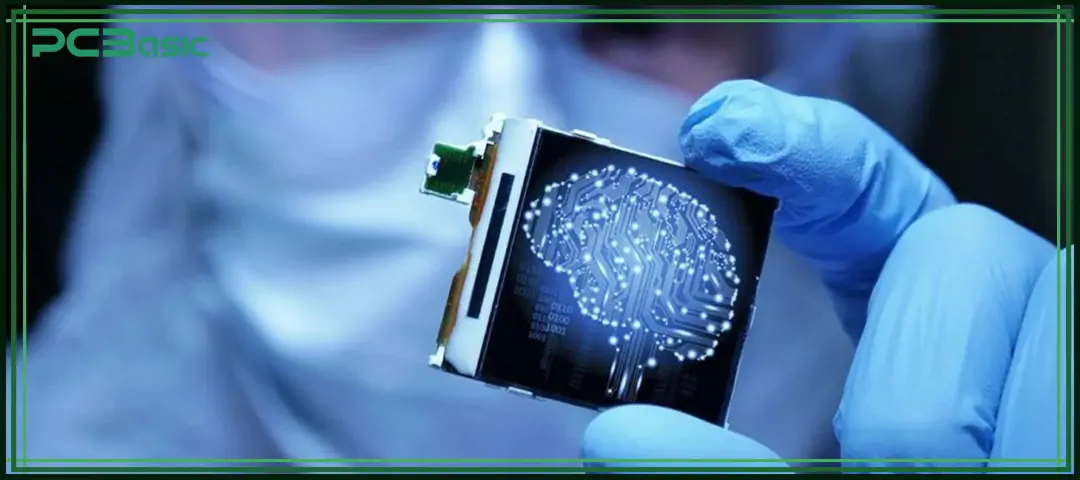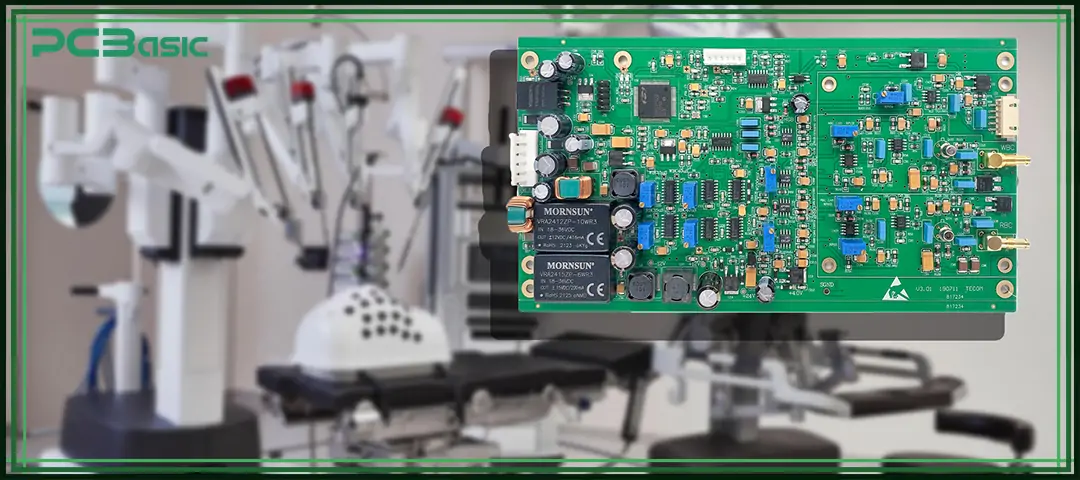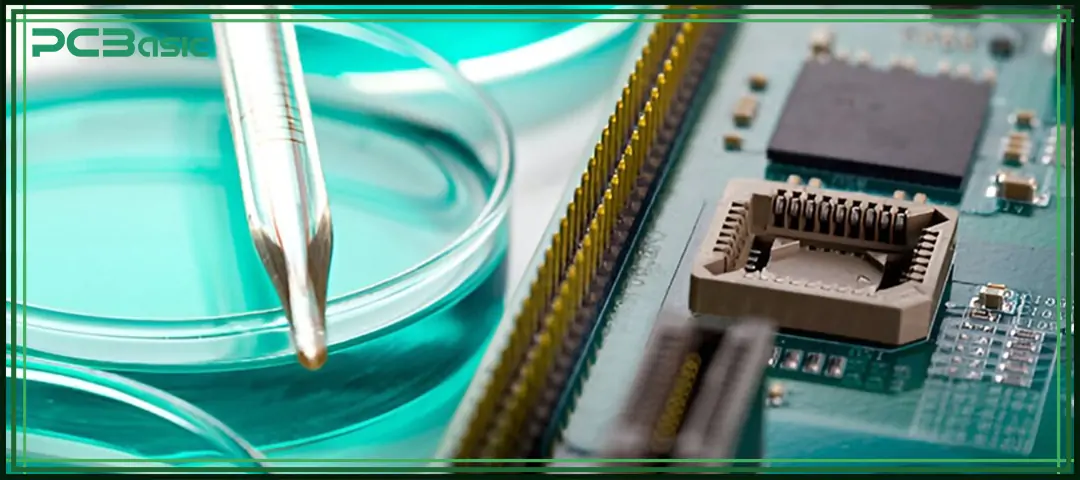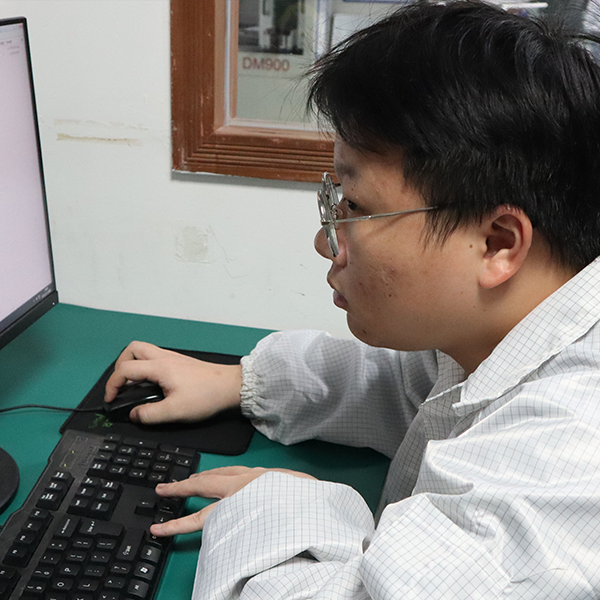

Global high-mix volume high-speed PCBA manufacturer
9:00 -18:00, Mon. - Fri. (GMT+8)
9:00 -12:00, Sat. (GMT+8)
(Except Chinese public holidays)


Global high-mix volume high-speed PCBA manufacturer
9:00 -18:00, Mon. - Fri. (GMT+8)
9:00 -12:00, Sat. (GMT+8)
(Except Chinese public holidays)
HomePage > Blog > Knowledge Base > Medical PCB and Medical PCB Assembly (by PCBasic)
In today's rapidly developing era of medical technology, electronic manufacturing technology has become a key force driving the precision, safety and innovation of medical equipment. All kinds of electronic medical devices cannot do without high-precision medical PCBs, which are the core foundation of modern medical electronics assembly.
Medical PCB assembly is not only a manufacturing process, but also an important stage that determines whether medical devices operate reliably and safely. Whether it is material selection, signal transmission design, or assembly, inspection and verification, every step directly affects whether the equipment can work precisely at critical moments. Meanwhile, all medical PCBs and PCBA must comply with strict international standards, such as ISO 13485, IEC 60601, FDA 21 CFR Part 820 and IPC Class 3, to ensure zero-failure operation in life-critical medical equipment.
As a leading medical PCB and PCBA manufacturer in Shenzhen, PCBasic has over 15 years of experience in the field of medical electronics manufacturing. PCBasic offers one-stop medical PCB assembly services, covering the entire process from PCB manufacturing, component procurement, SMT mounting, DIP insertion, testing, potting, conformal coating, and full box-build assembly.
This article mainly introduces the core knowledge of medical PCB and medical PCB assembly, including their definitions, types, manufacturing and inspection processes, international compliance standards, and the latest technological trends. At the same time, the advantages and solutions of PCBasic in this field will be highlighted to help you gain a deeper understanding of how medical PCBA supports the safety and innovation of modern medical devices.

In modern medical equipment, the medical PCB is one of the most crucial core components and is known as the "nerve center" of medical electronic systems. It is responsible for electrical connection and signal transmission, providing a stable power supply and data support for various sensors, processors, control chips and communication modules.
Unlike ordinary industrial circuit boards, medical PCBs have extremely high requirements for precision, reliability and safety. PCBs for medical devices must operate under the condition of zero failure tolerance. These circuit boards not only have to withstand high-frequency signals, heat and vibration, but also meet strict electromagnetic compatibility (EMC) and electrical safety requirements. At the same time, if a device is used in contact with the human body, medical PCBs must have good biocompatibility to prevent contamination or chemical reactions from causing harm to patients.
Common applications of medical PCB assembly include:
• Pacemakers and defibrillators
• Blood analyzers, glucose monitors, and biochemical testing systems
• Patient monitoring systems and wearable health devices
• Ultrasound and MRI imaging systems
• Surgical robots and diagnostic instruments
Since these devices all directly affect the safety of patients, manufacturers must strictly control every link in design, production and testing. An outstanding medical PCB manufacturer not only needs to have the ability to produce multi-layer boards, flexible boards and rigid-flex boards, but also must comply with international medical industry standards.
Different types of medical devices have different requirements for circuit design and materials. Therefore, there are various forms of medical PCBs. The following are the main categories:
|
Type |
Description |
Typical Medical PCB Applications |
|
Rigid PCBs |
Built from solid FR-4 or metal-core laminates for stability. |
Imaging equipment, infusion pumps |
|
Flexible PCBs |
Bendable, lightweight circuits ideal for wearable health devices. |
Biosensors, hearing aids |
|
Rigid-Flex PCBs |
Combine rigid layers with flexible connectors for compact 3D layouts. |
Portable diagnostic tools, endoscopes |
|
HDI PCBs |
High-density interconnects for miniaturized designs. |
Smart implants, micro sensors |
|
High-Frequency PCBs |
Low-loss materials for signal accuracy. |
MRI and CT systems |
To remain competitive in the medical industry, every medical PCB manufacturer must master these core technologies to achieve a balance between miniaturization, stability and high reliability of equipment.
The production of medical PCBs must strictly follow international standards to ensure the safety, reliability of the equipment and the protection of patients. Standards mainly include:
• ISO 13485:2016 – Defines quality management systems for medical device manufacturing.
• IEC 60601-1 / 60601-1-2 – Covers electrical safety and electromagnetic compatibility (EMC) requirements.
• FDA 21 CFR Part 820 – Regulates design and production quality for medical devices sold in the U.S.
• IPC-A-600 / IPC-A-610 / IPC-6012 / IPC-6013 – Establishes performance and acceptability standards for printed circuit boards and assemblies.
• RoHS & REACH Compliance – Restricts hazardous substances and ensures environmental safety.
At PCBasic, compliance is not an add-on to the process but a fundamental principle at every step of our medical electronics assembly. Every medical PCB used in medical devices is designed, manufactured and inspected under a standardized system to ensure true "safety, reliability and traceability".

Material Selection
High-quality medical PCBs must start with reliable board processing. In PCBasic, every medical PCB assembly project starts with material control to ensure that the circuit board is stable, reliable and safe for the human body. The materials we commonly use include FR-4, polyimide, Rogers high-frequency laminates and metal-core substrates, all of which are core materials for manufacturing high-performance PCBs for medical devices.
High-Precision Layering & Interconnection
During the production process, PCBasic adopts multi-layer lamination, laser microvia drilling and controlled impedance routing to ensure stable signal transmission in medical PCB applications, such as MRI systems, ECG electrocardiogram monitoring, patient monitoring equipment, etc. Meanwhile, through high-precision copper plating and plated through-hole (PTH) technology, we ensure reliable conduction of structural pads such as BGA, QFN, and microvia pad structures, making the entire medical PCBA more durable and stable.
Surface Finishing & Reliability Enhancement
After the circuit pattern is completed, the circuit board will undergo solder mask application, silkscreen printing and surface finishing processes, such as ENIG gold plating, ENEPIG or HASL. The role of surface finishing is extremely crucial. It can prevent the oxidation of solder pads and enhance the reliability of welding. ENIG is highly suitable for high-precision medical PCBs due to its flat surface and good solderability. ENEPIG is suitable for devices that require gold wire bonding or implantable devices, where medical PCB applications have higher requirements for reliability.
Cleanroom Production & Quality Compliance
All circuit boards are produced in a cleanroom environment. The factory is equipped with anti-static systems, temperature and humidity control, and HEPA filtration devices to prevent dust, moisture or contamination from affecting quality. As a professional medical PCB manufacturer, PCBasic fully complies with international medical standards such as ISO 13485, RoHS, REACH and IPC-6012, ensuring that each circuit board can be safely applied to life-related equipment. Our medical electronics assembly solutions have been widely used in critical medical PCB applications such as defibrillators, surgical robots, glucose meters, ultrasound and medical imaging.

Time is money in your projects – and PCBasic gets it. PCBasic is a PCB assembly company that delivers fast, flawless results every time. Our comprehensive PCB assembly services include expert engineering support at every step, ensuring top quality in every board. As a leading PCB assembly manufacturer, we provide a one-stop solution that streamlines your supply chain. Partner with our advanced PCB prototype factory for quick turnarounds and superior results you can trust.
SMT (Surface Mount Technology)
SMT is the first step to achieve precision medical PCB assembly. PCBasic operates 9 fully automatic high-speed production lines equipped with nitrogen reflow ovens, which can effectively reduce oxidation and improve soldering yield. We can precisely mount 0201 components, BGA, QFN and other high-density package components, and the soldering standards comply with IPC Class 3 medical grade requirements.
THT (Through-Hole Technology)
For components that require higher mechanical strength or need to carry large currents, we adopt THT technology. The PCBasic medical PCBA team uses both wave soldering and selective soldering to ensure that the solder joints are firm, durable and reliable, and comply with RoHS and lead-free standards, without generating any harmful substances.
Wave and Selective Soldering
Wave soldering is suitable for mass production, while selective soldering is applicable to mixed boards or temperature-sensitive areas, allowing for the soldering of only designated positions. This enables PCBasic to maintain stable and consistent quality both in small-batch prototyping and in large-batch production of PCBs for medical devices.
Conformal Coating & Potting
Medical devices are often used in disinfected environments and scenarios where moisture or body fluids may come into contact. Therefore, PCBasic will perform conformal coating or potting during medical PCB assembly. This can prevent the circuit board from getting damp, corroded, dusty or contaminated by bacteria, and is particularly suitable for critical medical PCB applications such as surgical equipment and life support systems.
Lead-Free & RoHS-Compliant Processes
Every medical electronics assembly process of PCBasic complies with RoHS and REACH environmental protection standards. Only lead-free solder and halogen-free materials are used in production, which is both environmentally friendly and does not affect electrical conductivity and soldering reliability, ensuring that all products can safely enter the global medical market.
Every medical PCBA must undergo a complete and strict testing process before leaving the factory to ensure the reliability of its electrical performance and functions.
AOI (Automated Optical Inspection)
By using a high-resolution 3D camera system, the quality of solder joints, polarity direction, and component position offset are detected to ensure there are no issues such as missing solder, misalignment, or wrong placement.
Flying Probe Testing & ICT (In-Circuit Testing)
Flying probe testing can perform continuity, short circuit and open circuit detection without the need for dedicated fixtures. ICT further examines parameters such as resistors, capacitors, diodes, and isolation circuits to ensure compliance with design standards.
X-Ray Inspection
It is mainly applied to the invisible solder joint areas, such as BGA and QFN, and is used to detect whether there are problems, such as voids, solder bridges, and insufficient soldering, in the internal solder joints.
Ionic Contamination Test
It detects the residual ion content on the surface of the PCBA to ensure that no flux residue or contaminants affect reliability and lifespan in medical environments.
Functional & Burn-In Testing
By simulating real usage environments, the PCBA is made to operate under continuous power-on, high temperature or load conditions to verify its long-term stability and reliability.
Through the above-mentioned strict inspection process, PCBasic ensures that each medical PCB complies with the medical-grade performance standards of ISO 13485 and IPC Class 3.

Manufacturing medical PCBs requires solving multiple technical challenges:
|
Challenge |
PCBasic’s Solution |
|
Miniaturization |
HDI technology and microvias enable compact yet powerful designs. |
|
Thermal Management |
Integration of thermal vias, copper planes, and high-conductivity materials. |
|
Signal Integrity |
Controlled impedance routing and low-loss laminates. |
|
Reliability |
Strict process validation, AOI + X-ray + flying-probe verification. |
|
Traceability |
MES + ERP + IoT digital systems track every stage of medical PCB assembly. |
These innovations make PCBasic a trusted medical PCB manufacturer for high-mix, low-volume precision builds.
Located in Shenzhen, China, PCBasic is a professional medical PCB manufacturer and provides complete electronic manufacturing services (EMS) from R&D, manufacturing, to assembly.
We offer a truly one-stop solution that integrates PCB manufacturing, medical PCB assembly, component sourcing, functional testing and box-build services in the same system, reducing communication costs, shortening delivery times and ensuring consistent quality.
PCBasic is certified to ISO 9001, ISO 13485, IATF 16949, RoHS, CE, and FCC standards. The products are widely used in medical equipment, industrial control, automotive electronics, Internet of Things and other fields, and customers are all over the world.
We have always adhered to four core values: Speed, Quality, Technology and Service, and used them as standards to promote the implementation and delivery of every medical PCBA project.
|
Capability |
Description |
|
Quick-Turn Prototypes |
24–48 h fabrication for urgent medical R&D. |
|
Multi-layer & HDI Boards |
Up to 40 layers with blind/buried vias. |
|
High-Precision Assembly |
9 SMT lines + nitrogen reflow + AOI/X-ray inspection. |
|
Testing & Validation |
Flying probe, ICT, and functional testing for every build. |
|
Engineering Support |
DFM/DFA analysis to eliminate design errors before production. |
|
Environmental Protection |
Conformal coating, potting, and thermal aging validation. |
PCBasic’s medical PCB assembly teams support both prototype and production orders, ensuring PCBs for medical devices are delivered on time and defect-free.
Whether you require complex multi-layer medical PCBs for imaging systems or flexible medical PCBA for wearable sensors, PCBasic ensures compliance, precision, and performance.
In today's medical industry, the reliability of medical PCB assembly is directly related to the life safety of patients. Whether it is lightweight wearable devices or complex diagnostic systems, every technological innovation is inseparable from PCBs for medical devices that comply with strict regulatory standards as the core support.
PCBasic offers globally leading medical PCB and medical PCBA solutions. Relying on advanced engineering technology, automated manufacturing systems, and international authoritative certifications, it ensures that every circuit board is safe, reliable, and traceable.

Assembly Enquiry
Instant Quote
Phone contact

+86-755-27218592
In addition, we've prepared a Help Center. We recommend checking it before reaching out, as your question and its answer may already be clearly explained there.
Wechat Support

In addition, we've prepared a Help Center. We recommend checking it before reaching out, as your question and its answer may already be clearly explained there.
WhatsApp Support

In addition, we've prepared a Help Center. We recommend checking it before reaching out, as your question and its answer may already be clearly explained there.
